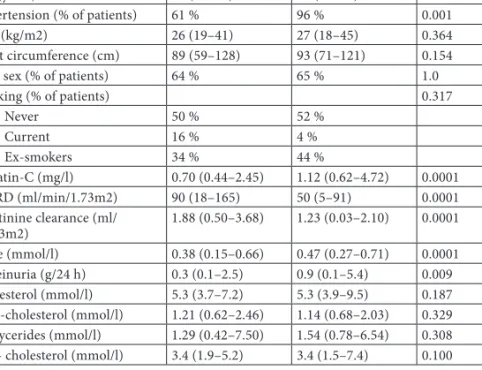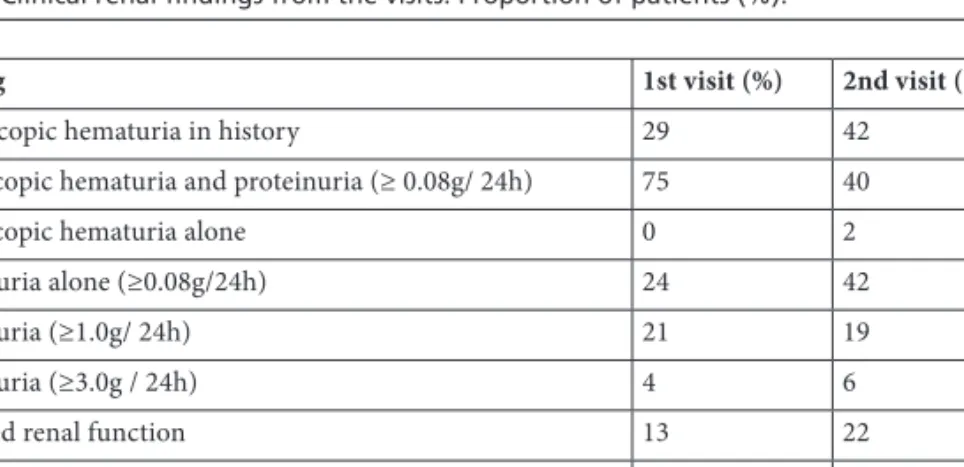Detailed information on alcohol consumption was obtained during the first visit and biomarkers evaluating alcohol use were obtained simultaneously. Mustonen: IgA immune responses to acetaldehyde adducts and biomarkers of alcohol consumption in patients with IgA glomerulonephritis.
INTRODUCTION
REVIEW OF THE LITERATURE
History and epidemiology of IgA glomerulonephritis
Etiology and pathogenesis of IgA glomerulonephritis
The main O-glycosylation abnormality found is reduced galactosylation of the hinge region O-glycans in the IgA1 molecule (Barratt et al. 2007a). However, patients with IgAGN have increased serum levels of galactose-deficient IgA1 compared to healthy controls (Moldoveanu et al. 2007).
Diagnosis and clinical features of IgA glomerulonephritis
Nevertheless, autosomal dominant inheritance with incomplete penetrance is a likely mode of transmission in families with IgAGN (Beerman et al. 2007). IgAGN occurs at all ages, the usual age at clinical onset being in the second and third decades of life (Donadio 2001, Berthoux et al. 2008).
Silent and secondary IgA glomerulonephritis
Treatment of IgA glomerulonephritis
- Medication
- Transplantation
The therapy appears to be well tolerated and effective in reducing proteinuria in normotensive patients (Shimizu et al. 2008). Tonsillectomy has been a popular form of therapy especially in Japan (Komatsu et al. 2008), but conflicting results have been published.
Renal outcome
Omega-3 fatty acids in patients with higher levels of proteinuria have been suggested as attempts to slow the progression of renal insufficiency (Tumlin et al. 2007). Much worse figures have also been reported, with a 10-year cumulative probability of renal survival of 33% (Chacko et al. 2005).
Prognostic determinants
- Impaired renal function
- Hypertension
- Proteinuria
- Histological features
- Sex and age
- Hyperuricemia, hypertriglyceridemia and weight
- Genetic markers of progression
- Other markers of progression
Adding mineralocorticoid receptor blockers to ACEI or ARB therapy may further reduce proteinuria (Bomback et al. 2008). The presence of gross histological lesions such as hyalinosis and crescents in the initial renal biopsy portends a poor prognosis (Berthoux et al. 2008).
Insulin resistance
- Defi nition of insulin resistance
- Assessment of insulin resistance
- Kidneys and glucose homeostasis
- Eff ect of insulin resistance on renal function
- Insulin resistance in kidney diseases
- Insulin resistance in IgA glomerulonephritis
The effects of insulin resistance on the kidney are complex and consist of both structural and functional changes (El-Atat et al. 2004). 73% of IgAGN patients had impaired glucose tolerance, but a possible relationship between renal function and insulin resistance was not reported (Kaneshige et al. 1983).

Infl ammation
- Defi nition of infl ammation
- Causes of infl ammation in kidney diseases
- Eff ect of infl ammation on renal function
- Infl ammation in kidney diseases
- Infl ammation in IgA glomerulonephritis
Elevated serum IL-6 has also been associated with decreased renal function (Shlipak et al. 2003, Keller et al. 2008). In another follow-up study in the elderly, higher CRP and WBC counts and lower serum albumin were independently associated with an increase in serum creatinine (Fried et al. 2004). Both IL-6 and CRP were found to differ significantly between CKD patients and healthy subjects, but the association between GFR and inflammation markers was not significant (Oberg et al. 2004).
However, only IL-6 was independently associated with residual GFR, while no similar analysis was reported for serum albumin or crp (Pecoits-Filho et al. 2003). Decreased serum albumin was independently associated with more severe kidney damage in the CRIB study (Landray et al. 2004). This is the only study that did not provide follow-up information in this regard (Friedman et al. 2005).
In another study of CKD patients, higher baseline CRP was independently associated with faster loss of renal function (Tonelli et al. 2005). However, this was explained by the significant correlation between serum albumin and urinary protein excretion (Rauta et al. 2002).

Alcohol
- Alcohol consumption and cardiovascular diseases
- Alcohol consumption and kidney function
- Alcohol consumption and IgA glomerulonephritis
- Evaluation and markers of alcohol consumption
It has been suggested that alcohol may positively affect renal function through mechanisms similar to those reported for cardiovascular disease (de Francisco et al. 2005). Amounts less than this appeared safe, although no statistically significant protective effect was found (Shankar et al. 2006). Above six units of alcohol per week was independently associated with an increase in GFR in men (Kronborg et al. 2008).
In another study, neither baseline alcohol consumption nor type of alcoholic beverage was significantly related to a risk of CKD (Stengel et al. 2003). Nevertheless, a case-control study from Japan has suggested that alcohol consumption has a protective effect against the development of IgAGN (Wakai et al. 1999); the greater the alcohol consumption, the lower the risk. In a subsequent study by the same group of researchers, the result no longer reached statistical significance (Wakai et al. 2002).
Titers of serum IgA autoantibody to acetaldehyde adducts may also provide a sensitive and specific marker of alcohol consumption (Worrall et al. Simple self-administered questionnaires appear to provide useful estimates of alcohol consumption (Giovannucci et al. 1991).
AIMS OF THE PRESENT RESEARCH
SUBJECTS AND METHODS
Subjects
- Patients
- Controls
- Clinical data
- Ethical aspects
Patients with diabetes mellitus were included in the published analyzes and repetition of the statistics after their exclusion yielded similar results (I) (data not shown in this thesis). There were no cases of SLE or cirrhosis of the liver at the time of renal biopsy or during follow-up. No cases of Crohn's disease were noted, but two patients had ulcerative colitis at the time of renal diagnosis and another was diagnosed during follow-up.
For these analyses, hypertension was defined as use of antihypertensive medications or systolic blood pressure (BP) > 140 mmHg or diastolic blood pressure (DBP) > 90 mmHg at visits. Six patients had diabetes at the time of renal biopsy, and 19 new diabetes patients developed during follow-up. The median body mass index (BMI) was 26 kg/m2 (18-45) at the first visit and 27 kg/m2 (18-43) at the second visit, with the patients slightly overweight and the tendency between gradually increased. time.
Thirteen percent of patients smoked at the first visit, 16% at the second. The study protocol was approved by the Tampere University Hospital Ethics Committee, and the study was conducted in accordance with the provisions of the Declaration of Helsinki.

Methods
- Study protocols
- Laboratory determinations
- GFR estimates
- Defi nition of progression of IgA
- Insulin concentration and HOMA-IR
- Infl ammatory markers
- Alcohol consumption markers and liver
- Other laboratory variables
- Defi nition of alcohol consumption
- Statistical analyses
The lowest detection level of the kit was 2 μU/ml in a 100-μl sample, specificity for human insulin 100% and for human proinsulin < 0.2%, mean for intra- and inter-assay variations of 3.2% and 3.88% , and normal insulin concentrations are 5–15 μU/ml (all values as reported by the manufacturer). WBCs were analyzed using in-house routine analytical methods at the Tampere University Hospital laboratory. Serum urate, GGT, ALT, AST and ALP (IV) were measured by standard clinical chemistry methods in the same laboratory in Seinäjoki.
The IgA antibody against acetaldehyde-modified hemoglobin (IgA anti-adduct) (IV) was analyzed in the Seinäjoki Central Hospital laboratory with an ELISA technique. Other laboratory variables were analyzed using serum samples, spot and collection urine samples using routine in-house analytical methods at the Tampere University Hospital laboratory. In the alcohol consumption study (III) the self-reported level of alcohol consumption and the score from the CDT analysis were used to divide the study population into 4 categories: 0 g/week = abstainers, 0 g–80 g/week = light consumer, 80 g. – 280 g/week (men) and 80 g –190 g/week (women) = moderate consumers and ≥ 280 g/week (men) and ≥ 190 g/week (women) = heavy consumers, based on national recommendations for definition. of heavy drinking (Aalto and Seppä 2007).
The division differed in the two alcohol studies, as 4 categories were more suitable for determining the level of protective and harmful consumption. Associations between categorical variables and normally distributed variables were analyzed by Student's t-test or one-way ANOVA, depending on the number of categories.
RESULTS
- Kidney function and progression of IgA glomerulonephritis
- Comparison between progressive and stable patients (I,II)
- Insulin resistance in IgA glomerulonephritis (I)
- Infl ammatory markers in IgA glomerulonephritis (II)
- Alcohol consumption in IgA glomerulonephritis (III)
- Clinical and laboratory variables in diff erent alcohol
- Alcohol consumption and kidney function
- Alcohol consumption and kidney function in univariate
- Alcohol consumption markers in IgA glomerulonephritis (IV) . 58
- Patient characteristics
- Estimates of kidney function
- Defi nition of progression and rate of progression
- Insulin resistance in IgA glomerulonephritis
- Infl ammatory markers
- CRP in IgA glomerulonephritis
- Serum albumin in IgA glomerulonephritis
- Serum IL-6 in IgA glomerulonephritis
- WBC in IgA glomerulonephritis
- Eff ect of alcohol consumption in IgA glomerulonephritis
- Assessments of alcohol consumption in IgA
- Infl uence of gender on alcohol studies in IgA
However, the proportion of patients progressing was 31%, which is approximately the same as in this series (Rauta et al. 2002). A recent Japanese report, including only patients with IgAGN, found no association between insulin resistance and renal function (as measured by ccl and serum creatinine), but did show an association between insulin resistance and hypertension (Eiro et al. 2003). Two previous studies reported that BMI at the time of diagnosis was significantly higher in the progressive group (Syrjänen et al. 2000, Bonnet et al. 2001).
The earliest report does not include an ultra- or highly sensitive CRP assay (Tencer et al. 1995), in contrast to other publications. Several components of the metabolic syndrome (SBP, BMI, waist circumference, HDL, TG, insulin, urate) were also correlated with CRP, confirming previous observations in the non-renal population in the IRAS study (Festa et al. 2000) and observations in patients with IgAGN (Nelson et al. 2005). One Finnish study showed that in patients with a better GFR (≥ 85 mL/min) at presentation, serum albumin was a significant predictor of renal survival in univariate analysis; however, this finding was explained by the significant correlation between serum albumin and urinary protein excretion (Rauta et al. 2002).
In another report, WBC was significantly higher in IgAGN compared with matched healthy controls, but no other information about this variable was provided (Nelson et al. 2005). With serum creatinine, no significant differences were found between alcohol consumption groups, while with other estimates (eGFR(C-G) and eGFR(MDRD)) significant differences were observed (Chung et al. 2005). Under-reporting of alcohol intake is particularly common in healthcare settings, especially among women (Seppä et al. 1994, Lappalainen-Lehto et al. 2005).
Studies on specific IgA responses seem particularly interesting, as IgAN is known to involve specific abnormalities in the IgA system (Barratt et al. 2007b).

SUMMARY AND CONCLUSIONS
Bailey RR, Lynn KL, Robson RA, Smith AH and Wells JE (1994): Long-term follow-up of patients with IgA nephropathy. Donadio JV (2001): The emerging role of omega-3 polyunsaturated fatty acids in the treatment of patients with IgA nephropathy. Significance of serum IgA levels and serum IgA/C3 ratio in diagnostic analysis of patients with IgA nephropathy.
Angiotensinogen gene variation and renoprotective efficacy of renin-angiotensin system blockade in IgA nephropathy. Ohno I, Hosoya T, Gomi H, Ichida K, Okabe H and Hikita M (2001): Serum uric acid and renal prognosis in patients with IgA nephropathy. Factors associated with the progression of IgA nephropathy correlate with renal function - a model for assessing the risk of progression in mild disease.
Glomerular activation of the lectin complement in IgA nephropathy is associated with more severe renal disease. Syrjänen J, Mustonen J and Pasternack A (2000): Hypertriglyceridemia and hyperuricemia are risk factors for progression of IgA nephropathy.






